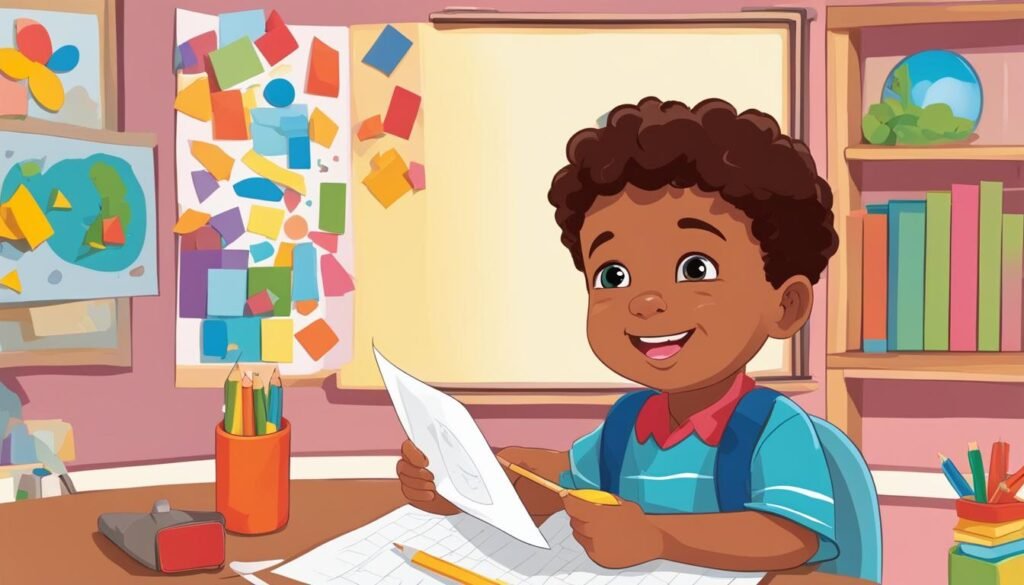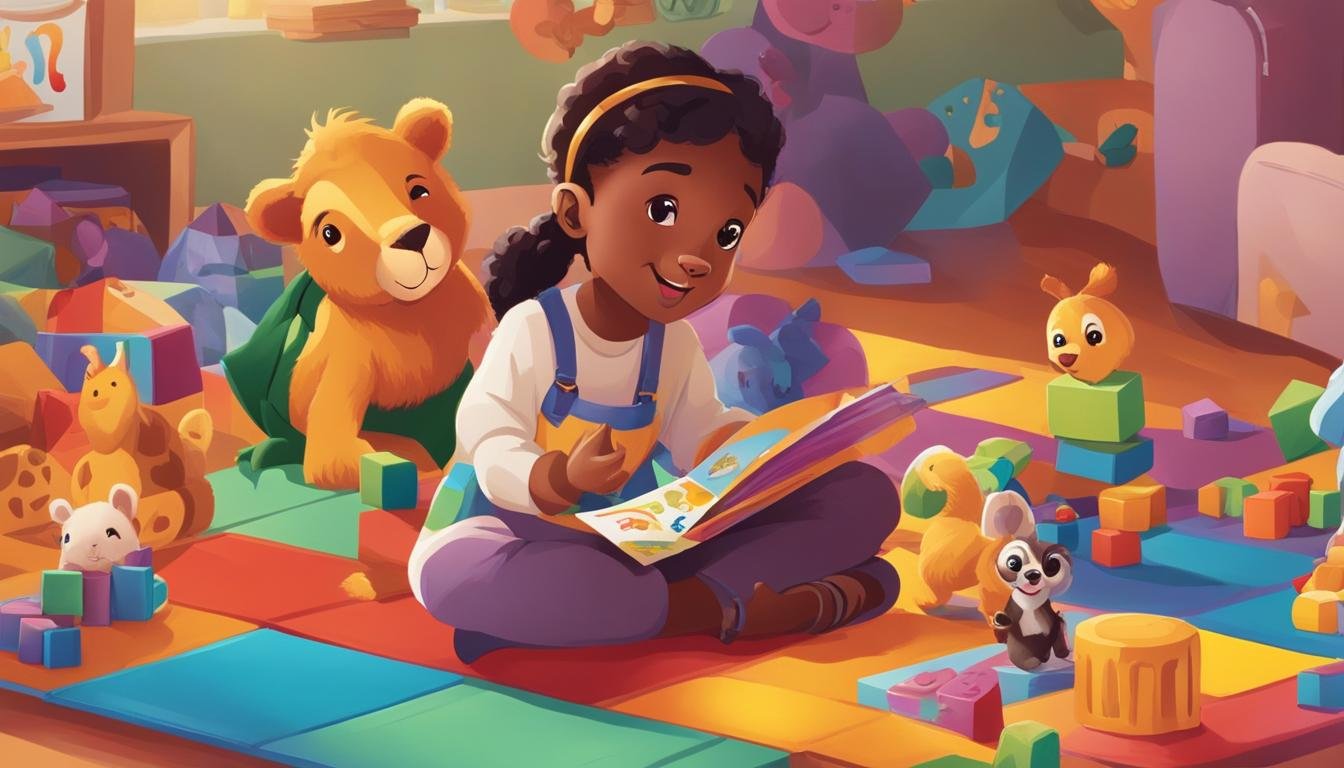Why questions play a pivotal role in speech therapy as they contribute to cognitive development and improved communication skills. They help children understand cause and effect, reasoning, and critical thinking. By teaching and addressing why questions in speech therapy sessions, therapists can assist children in enhancing their language abilities and overall communication.
Key Takeaways:
- Why questions are crucial for cognitive development and communication skills in speech therapy.
- They aid in understanding cause and effect, reasoning, and critical thinking.
- Addressing why questions helps enhance language abilities and overall communication in children.
- Visual support and strategies are valuable tools in teaching why questions in speech therapy.
- Engaging activities can be utilized to practice and reinforce why questions in therapy sessions.
Types of Why Questions in Speech Therapy
In speech therapy, why questions can be classified into different types, each serving a specific purpose in language development. By understanding these different types of why questions, speech therapists can tailor their approach to address specific skills and abilities in children.
1. Why questions about function:
These types of why questions focus on understanding the purpose and function of objects or actions. By asking children why we use certain objects or perform specific actions, therapists help children grasp the practicality and relevance of everyday items and activities.
For example: “Why do we wear hats in the summer?”
2. Why questions about people’s motivations:
These why questions aim to develop perspective-taking skills by understanding people’s motivations for their actions. By exploring the reasons behind others’ behavior, children learn to consider different perspectives and develop empathy.
For example: “Why do you think she shared her toy with her friend?”
3. Hypothetical why questions:
Hypothetical why questions encourage children to think abstractly and reason about various scenarios. By posing hypothetical situations and asking why certain outcomes might occur, therapists promote critical thinking and problem-solving skills.
For example: “Why do you think it would be beneficial to have wings like a bird?”
4. Mixed why questions:
Mixed why questions allow for practice in real-life conversations, combining elements of all the types mentioned above. These questions simulate natural communication and encourage children to apply their understanding of why questions in various contexts.
For example: “Why does your teacher ask you to raise your hand before speaking?”
Understanding the different types of why questions in speech therapy allows therapists to design targeted interventions and activities that cater to children’s specific needs. By incorporating various types of why questions, therapists can provide a well-rounded approach to language development and cognitive skills enhancement.
The Benefits of Visual Support in Teaching Why Questions
Visual support can be a powerful tool in speech therapy sessions when targeting why questions. By incorporating visual cues and prompts, therapists can enhance comprehension and facilitate language development in children with communication difficulties. Using visual support provides a visual reminder of the meaning of wh question words, helping children connect the question word to its corresponding meaning.
One effective way to utilize visual support is by using pictures to answer why questions. By providing picture-supported answer choices, children can select the appropriate response when answering why questions. This not only reinforces their understanding of cause and effect but also encourages them to express their thoughts effectively.
“Visual support can significantly enhance the learning experience for children with communication challenges. It provides a concrete representation of abstract concepts, making the therapy more engaging and accessible.” – Speech Therapist
Visual prompts are another valuable component of visual support in teaching why questions. These prompts can include symbols or images that represent each wh question word, such as a person for “who” or a clock for “when.” By associating the question word with a visual cue, children have a visual reminder to help them understand and respond to why questions accurately.

Benefits of Visual Support:
- Enhances comprehension of wh question words
- Supports language development in children with communication difficulties
- Provides a visual reminder of the question word’s meaning
- Reinforces understanding of cause and effect
- Encourages effective expression of thoughts
Visual support plays a crucial role in speech therapy, particularly when teaching why questions. By incorporating visual cues, picture-supported answer choices, and visual prompts, therapists can create a more engaging and effective learning experience for children, ultimately enhancing their communication skills and overall language development.
Strategies for Targeting Why Questions in Speech Therapy
When working on why questions in speech therapy, implementing effective strategies can greatly enhance a child’s understanding and ability to express themselves. Here are some key techniques that speech therapists use:
- Using Stories and Videos: Incorporating stories or videos into therapy sessions can be a powerful tool for teaching why questions. By analyzing the motivations and actions of characters, children gain insight into the cause-and-effect relationships that drive human behavior.
- Incorporating Real-Life Scenarios: Bringing real-life situations into therapy provides opportunities for children to apply why questions to their daily experiences. By discussing reasons behind actions and behaviors in familiar contexts, children can better generalize their understanding of why questions.
- Employing Cause-and-Effect Questions: Asking cause-and-effect questions encourages children to think critically about the consequences of certain actions or events. This strategy builds their understanding of the relationship between actions, outcomes, and the reasons behind them.
By utilizing these strategies, speech therapists can create engaging and interactive sessions that target why questions effectively. These techniques foster critical thinking, reasoning skills, and language development in children with communication difficulties.
Testimonials
“Using stories and videos in speech therapy has been a game-changer for my child. It’s amazing how they can now analyze the characters’ motivations and understand cause and effect in everyday situations!” – Parent
“Incorporating real-life scenarios has made therapy sessions more meaningful for my child. They can now apply their understanding of why questions to their own experiences, making progress faster!” – Speech Therapist
Targeted Speech Therapy Activities for Why Questions
Engaging in specific activities can further reinforce a child’s grasp of why questions. Here are some recommended activities:
- Role-playing: Encourage children to act out scenarios where they have to explain the reasons behind their actions, fostering their ability to articulate why questions.
- Using Visual Aids: Incorporate visual cues such as pictures or symbols to help children understand and answer why questions. These visual supports enhance comprehension and aid in language development.
- Creating Scenarios: Present children with hypothetical situations and ask them to generate why questions. This activity promotes critical thinking and encourages the exploration of different perspectives.
By implementing these strategies and activities, speech therapists can effectively target why questions, fostering cognitive development and enhancing communication skills in children.
Recommended Activities for Practicing Why Questions in Speech Therapy
Incorporating engaging activities is an effective way to practice why questions in speech therapy. These activities not only make learning fun but also provide valuable opportunities for children to develop their language and critical thinking skills. Here are some recommended activities to enhance the practice of why questions in speech therapy:
- Firefly-Themed Activity for Why Questions: Create a firefly-themed activity where children can practice answering why questions. Use basic prompts such as “Why do fireflies light up?” or “Why do fireflies come out at night?”. This activity encourages children to think about cause and effect relationships, fostering their ability to understand and answer why questions.
- Digital Task Cards for Why Questions: Utilize digital task cards that present picture-supported answer choices for why questions. This interactive and engaging activity allows children to select the appropriate response from multiple options. It helps them develop their comprehension skills and provides visual support to aid in answering why questions effectively.
- Answering Why Questions Using Causal Conjunctions: Teach children to answer why questions using causal conjunctions such as “because” or “so.” For example, ask them “Why did the character go to the store?” and encourage them to respond with “Because they needed to buy groceries.” This activity helps children understand cause and effect relationships and enhances their ability to express their reasoning and explanations.
- Historical-Themed Comprehension Activity: Incorporate a historical-themed comprehension activity into speech therapy sessions. Use historical events or figures as the context for why questions. For instance, ask children “Why did Rosa Parks refuse to give up her seat on the bus?” This activity not only engages children in learning about history but also challenges them to think critically and provide meaningful answers to why questions.
These activities provide diverse ways to practice why questions in speech therapy. By incorporating fun and interactive elements, therapists can create an engaging learning environment that enhances children’s language and communication skills.

Summary:
Practicing why questions in speech therapy can be made enjoyable and effective through various activities. A firefly-themed activity targets cause and effect relationships, while digital task cards with picture-supported answer choices enhance comprehension. Encouraging the use of causal conjunctions helps children develop complex sentence structures and explain cause and effect. Historical-themed comprehension activities provide context for answering why questions and promote critical thinking. By incorporating these activities, speech therapists can facilitate the development of language and communication skills in children.
Conclusion
Incorporating why questions in speech therapy is vital for promoting cognitive development and enhancing communication skills. By teaching children to understand and ask why questions, speech therapists can empower them to think critically, express their thoughts effectively, and engage in meaningful conversations. Through targeted strategies and engaging activities, why questions become an essential component of speech therapy, contributing to the overall growth and progress of individuals with communication challenges.
FAQ
Why are why questions important in speech therapy?
Why questions play a pivotal role in speech therapy as they contribute to cognitive development and improved communication skills. They help children understand cause and effect, reasoning, and critical thinking. By teaching and addressing why questions in speech therapy sessions, therapists can assist children in enhancing their language abilities and overall communication.
What are the types of why questions in speech therapy?
In speech therapy, why questions can be classified into different types. The first type focuses on function, where children are asked why we use certain objects or perform specific actions. The second type involves understanding people’s motivations for their actions, enabling children to develop perspective-taking skills. The third type comprises hypothetical why questions, which encourage children to think abstractly and reason about various scenarios. Lastly, mixed why questions allow for practice in real-life conversations, applying all types of why questions.
How can visual support be beneficial in teaching why questions in speech therapy?
Visual support can be highly beneficial in teaching why questions in speech therapy. By presenting visual symbols or cues for each wh question word, such as a person for “who” or a clock for “when,” children have a visual reminder of the question word’s meaning. Additionally, using picture-supported answer choices can help children provide appropriate responses when answering why questions. Visual prompts enhance comprehension and support language development in children with communication difficulties.
What are some strategies for targeting why questions in speech therapy?
There are several effective strategies for targeting why questions in speech therapy. One approach is to use stories or videos and ask children why characters acted in a certain way or made specific decisions. This allows them to understand people’s motivations. Another strategy involves incorporating real-life scenarios into therapy, encouraging children to think about reasons for daily actions and behaviors. Cause-and-effect questions, which prompt children to understand the consequences of certain actions or events, are also valuable in teaching why questions.
What activities can be utilized to practice why questions in speech therapy?
There are various activities that can be utilized to practice why questions in speech therapy. A firefly-themed activity engages children by targeting why questions with basic prompts about who, what, when, where, and why. Digital task cards provide a no-print interactive activity for answering why questions with picture-supported answer choices. Answering why questions using causal conjunctions helps children develop complex sentence structures while explaining cause and effect. Additionally, a historical-themed comprehension activity allows children to practice answering why questions in the context of historical events.

